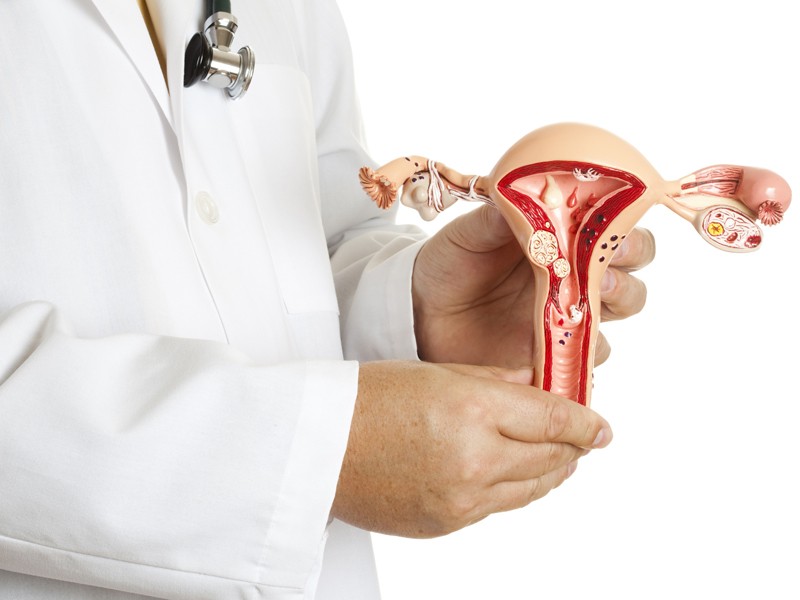Adenomyosis of the uterus

Today we will tell you about a disease of the uterus, which ranks third among the most common female diseases – uterine adenomyosis.
But before that, we will briefly consider the structure of the uterus.
The uterus is the female organ of the reproductive system, which consists of three layers:
- Perimetry -is external, serous membrane. Actually, it is a sheet of the peritoneum that covers the uterus from the outside.
- Myometrium – is a muscle layer. Consists of smooth muscles.It is with the help of its contractions that childbirth occurs naturally.
- Endometrium – is the inner lining of the uterus. The main function of the endometrium is to create optimal conditions for the attachment of a fertilized egg to the wall of the uterus. Therefore, every month before ovulation, it grows and if there was no fertilization, then during menstruation its functional layer comes out.
Adenomyosis of the uterus is a benign disease characterized by the proliferation of the lining of the uterus (endometrium) inside the muscular wall of the uterus. Actually, due to such ingrowth, the size of the uterus increases significantly. Usually, the disease begins in women after thirty years and if it is started by the disease, it can lead to infertility.
What are the symptoms of adenomyosis?
Symptoms depend on the stage of the disease, the age of the patient, and overall health. The following symptoms are distinguished:
- Violation of menstruation. Profuse, prolonged (more than 7-8 days) and very painful periods. Discharge can often be clotted. A few days before and after menses, brown, spotting may occur.
- Pain during sex
- Abnormal uterine bleeding that occurs between periods and is accompanied by sharp, cutting pains.
- Feeling of bloating in the lower abdomen due to the enlargement of the uterus. Sometimes the size of the uterus can increase 2-3 times, and the uterus itself can become lumpy.
- A woman may complain about the absence of pregnancy throughout the year.
What causes adenomyosis?
For sure, today gynecologists cannot tell the cause of the development of the disease. Actually, hormonal disorders and weak immunity are a common cause. Often adenomyosis occurs after surgery on the uterus, abortion, after curettage.
But doctors identify the following risk factors that can become a mechanism for the development of the disease:
- A large number of abortions;
- Frequent surgical interventions on the uterus;
- Many cesarean sections;
- Chronic inflammatory diseases of the uterus;
- Promiscuous sex life;
- Using the uterine spiral;
- Uncontrolled intake of hormonal drugs;
- Heavy physical activity;
- Constant stress and neuroses.
Classification of adenomyosis
There are several forms of adenomyosis:
- diffuse – uniform germination of the endometrium into the myometrium;
- focal – the formation of separate foci of growth;
- nodular – nodules form in places of germination;
- diffuse-nodal – uniform growth with the formation of universities.
And also, they are divided into 4 degrees, depending on the development of the disease:
- I degree – shallow germination, not further than the submucosa;
- II degree – the endometrium reaches half of the muscle layer;
- III degree – germination of more than half of the myometrium;
- IV degree – the endometrium grows into the entire muscle layer, sometimes it affects neighboring organs.
How does a doctor confirm adenomyosis?
Usually the condition has quite pronounced symptoms and the woman immediately seeks a doctor. And already at the stage of conversation and gynecological examination in the chair, one can suspect adenomyosis.
To confirm the diagnosis, ultrasound diagnostics (conventional and transvaginal), hysteroscopy with curettage of the endometrium and subsequent histological examination of it and MRI of the pelvic cavity organs are prescribed.
During all of them, the doctor looks at the shape of the uterus, the thickness of the walls, the presence of neoplasms or nodes, the spread of the process to neighboring organs. Also, for accurate differential diagnosis, gynecological smears are examined for flora and cytology and biopsy of the uterine wall.
Since the size of the uterus normally changes during the menstrual cycle, the doctor prescribes an instrumental diagnostic method on certain days of the cycle. Thus, he can tell exactly if there are deviations from the norm.
In order to determine the cause of the disease, laboratory tests are prescribed: the hormonal status of a woman, a biochemical blood test, a general analysis of urine and blood.
How is adenomyosis treated?
Treatment of adenomyosis is selected individually, depending on the form of the disease, the degree of the process, concomitant diseases, as well as the possible cause that provoked it.
Often, the disease goes away after menopause and therefore the method of treatment may depend on the woman’s age. Considering all possible factors, the doctor can prescribe: conservative treatment, surgical and extreme hysterectomy.
Conservative. At the initial stages and without pronounced symptoms, the doctor prescribes drug treatment, which includes: anti-inflammatory drugs, hormonal therapy and vitamins to maintain immunity. And also actively treat concomitant diseases.
It is possible to use sedatives after consulting a specialized doctor. Often, such activities help a woman and stop the further development of the disease, transferring it to the stage of remission.
Surgical. With a focal and nodal process, the lesions and the formation of nodes are excised by a surgical method. And after that, medication is also used to prevent relapses.
Sometimes the process is spread throughout the entire uterus and conservative treatment does not help, and it is impossible to remove individual foci with a surgical method.
But the symptoms are painful, uncomfortable, and sometimes life threatening. Then doctors recommend radical surgical removal of the uterus. More often this method is used for young women with grade IV disease and very severe symptoms.
Is it possible to have a child ?!
For women with adenomyosis who are planning to conceive a child, it is impossible to become pregnant during treatment, as well as 6 months after a full course.
But in women with concomitant hormonal disorders, doctors recommend using in vitro fertilization.
IVF – in vitro fertilization – an auxiliary method of fertilization. An egg is taken from a woman, sperm is taken from a man and combined outside the body. Then the fertilized egg is implanted into the woman’s uterus. This method increases the chances of getting pregnant and carrying a healthy baby.
And in the case of a hysterectomy, it is impossible to get pregnant. Therefore, the only method to get genetically your own, healthy child is surrogate motherhood.
Surrogacy is an assisted reproductive technology that makes it possible for a woman to have a child without a uterus. It consists in the fact that biological material (sperm and egg) is taken to the parents, fertilized using IVF and then the embryo is transferred into the uterine cavity to another woman who agrees to bear and give birth to a child.
Thus, this procedure has such positive aspects:
- Children will look like their parents;
- The married couple will have children;
- A completely healthy woman will bear and give birth to a child, in turn, reduces the risks;
- The couple is confident in the child’s genetic health and knows who he will look like;
Remember that early diagnosis and timely treatment often play a crucial role in the treatment of adenomyosis. And if the disease cannot be cured, and a woman wants to have her child, then in modern medicine there are assisted reproductive technologies that will give her such an opportunity!


